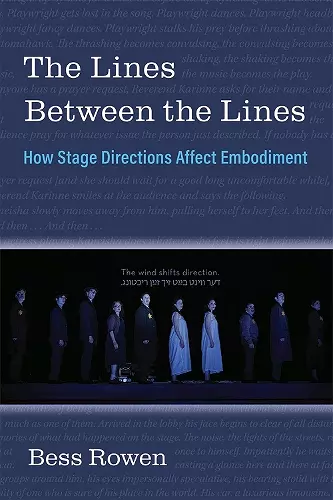The Lines Between the Lines
How Stage Directions Affect Embodiment
Format:Paperback
Publisher:The University of Michigan Press
Published:18th Oct '21
Currently unavailable, our supplier has not provided us a restock date

What is the purpose of a stage direction? These italicized lines written in between the lines of spoken dialogue tell us a great deal of information about a play's genre, mood, tone, visual setting, cast of characters, and more. Yet generations of actors have been taught to cross these words out as records of previous performances or signs of overly controlling playwrights, while scholars have either treated them as problems to be solved or as silent lines of dialogue. Stage directions can be all of these things, and yet there are examples from over one-hundred years of American playwriting that show that stage directions can also be so much more. The Lines Between the Lines focuses on how playwrights have written stage directions that engage readers, production team members, and scholars in a process of embodied creation in order to determine meaning. Author Bess Rowen calls the products of this method “affective stage directions” because they reach out from the page and affect the bodies of those who encounter them. Affective stage directions do not tell a reader or production team what a given moment looks like, but rather how a moment feels. In this way, these stage directions provide playgrounds for individual readers or production teams to make sense of a given moment in a play based on their own individual cultural experience, geographic location, and identity-markers. Affective stage directions enable us to check our assumptions about what kinds of bodies are represented on stage, allowing for a greater multitude of voices and kinds of embodied identity to make their own interpretations of a play while still following the text exactly. The tools provided in this book are as useful for the theater scholar as they are for the theater audience member, casting director, and actor. Each chapter covers a different function of stage directions (spoken, affective, choreographic, multivalent, impossible) and looks at it through a different practical lens (focusing on actors, directors, designers, dramaturgs, and readers). Every embodied person will have a slightly different understanding of affective stage directions, and it is precisely this diversity that makes these stage directions crucial to understanding theater in our time.
"As a whole, The Lines Between the Lines delivers on the promises outlined in its title and introduction: to uncover the affective elements of stage directions that occur in production, embodiment, and performance. Working deftly through a variety of theoretical perspectives, particularly semiotics, performativity, and affect theory, Rowen opens up a purportedly boring, possibly constraining, and always imperative aspect of scripts and illustrates its radical potential for multiplicity and fanciful engagement."
-- Tison Pugh, Tennessee Williams Annual Review"The Lines Between the Lines is a richly valuable new interrogation of a still somewhat under-explored element of theatre practice and scholarship."
-- Hannah Simpson, The Year's Work in Critical and Cultural Theory"The book pulls off an astonishing feat by being both a typology of stage directions and a stirring call to action. Rowen's hortatory tone drives the prose, performing the criminally uncommon feat of marrying theory and analysis to practicable suggestions and provocations toward performance and production practices..."
-- Theatre Survey"This timely investigation, which re-frames our historical and contemporary understandings of the roles that stage directions play in affecting all bodies that encounter them, establishes a productive path forward for those who write, embody, and analyse stage directions. It rightfully recognizes affective stage directions as tools that prompt creative, inclusive choices in both imagined and staged performances and establishes the groundwork for future studies on the relationship between affect and embodiment on stage."
-- Kaitlyn Farrell Rodriguez, Modern Drama"Rowen consistently models a scrupulous and innovative method for reading affective stage directions, and the field would be wise to take up her invitation to extend the work beyond this book’s thoughtfully defined parameters. So, too, would twenty-first-century theater artists who feel compelled by but also frustrated with O’Neill and his plays. As Rowen shows, the author’s copious stage directions can provide them with opportunities to exercise a creative authority that is all their own."
-- Jennifer Buckley, Eugene O'Neill Review"In an ambitious project that bridges theoretical analysis and practical application, Bess Rowen considers the significance and importance of stage directions within the theatrical text in The Lines between the Lines: How Stage Directions Affect Embodiment. Tracing the evolution of stage directions from the twentieth century on, Rowen argues that stage directions offer a path toward interrogating the cultural processes of theatre to challenge, subvert, and transform how we think about representation."
-- Catherine Heiner, Journal of Dramatic Theory and Criticism"Rowen inspires and guides the reader to tend to their own embodied reactions. While "[c]ross[ing] out these descriptions" may give production teams and actors a sense of resisting the authority of the playwright, Rowen's methodology provides an alternative that systematically reconfigures this relationships. For all the attention we give to bodies who perform on stage, The Lines Between the Lines reminds us that text, just as vitally, performs on the body."
-- Tyler Graham, Theatre Journal"Rowen makes clear throughout that embracing stage directions is an opportunity for theatre practitioners to collaborate with the playwright even when they are unable to be a part of the production process. The Lines Between the Lines is a great tool for most theatre artists."
-- Jackie Rosenfeld, Theatre AnISBN: 9780472054367
Dimensions: unknown
Weight: unknown
258 pages